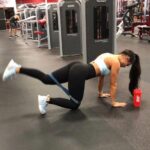Are you ready to take your fitness routine to the next level? In this article, we will explore the key steps on how to choreograph a fitness routine that is effective, engaging, and tailored to your specific goals. Whether you are a beginner looking to establish a solid workout routine or a fitness enthusiast seeking to revamp your current regimen, understanding the importance of a well-choreographed fitness routine is essential for long-term success.
Setting clear and achievable fitness goals is the first step in creating a personalized workout plan. By identifying your objectives and targeted areas, you can tailor your exercises to meet your specific needs. From strength training to cardiovascular workouts, choosing the right exercises that align with your goals is crucial in building an effective routine.
Once you have established your goals and chosen the appropriate exercises, creating a flow within your workout sequence is essential for maximizing results. By understanding how different exercises complement each other and sequencing them in a logical order, you can ensure that each move complements the next for optimal impact on your fitness journey. Throughout this article, we will delve into various aspects of choreographing a fitness routine to help you achieve lasting results and set yourself up for success.
Setting Your Goals
When it comes to choreographing a fitness routine, one of the most important steps is setting clear and achievable goals. Whether you want to lose weight, build muscle, improve endurance, or enhance flexibility, identifying your fitness objectives will guide the structure of your routine. Start by considering what specific areas of your body you want to target and what overall results you hope to achieve.
Defining Your Fitness Objectives
Before diving into creating a fitness routine, take some time to define your overarching fitness objectives. Ask yourself questions like: What do I want to accomplish with this routine? Am I looking to tone specific muscle groups or improve my overall cardiovascular health? By clearly defining your goals, you can tailor your exercises and workouts to ensure that they align with what you want to achieve.
Targeted Areas
In addition to setting broader fitness objectives, it’s essential to identify specific areas of focus within your routine. For example, if you want to work on building strength in your lower body, you might prioritize exercises like squats, lunges, and calf raises. Or if you’re aiming for improved flexibility, incorporate stretches and yoga poses into your routine. Identifying these targeted areas will help you select the right exercises and movements that align with your fitness goals.
By taking the time to set clear fitness objectives and identify targeted areas for improvement, you can create a well-choreographed fitness routine that is tailored specifically to meet your needs. This personalized approach will not only keep you motivated but also ensure that your efforts are directed towards achieving meaningful results.
Choosing the Right Exercises
To begin, it’s essential to identify which muscle groups you want to focus on and improve. Whether it’s strengthening your legs, toning your arms, or developing your core, understanding your fitness objectives will guide you in choosing the right exercises for your routine. For example, if you’re looking to build strength in your lower body, incorporating squats, lunges, and deadlifts would be beneficial.
In addition to targeting specific muscle groups, it’s also beneficial to include compound movements that engage multiple muscles at once. Exercises like burpees, mountain climbers, and push-ups are great examples of compound movements that provide a full-body workout. This not only saves time but also helps improve overall functional strength. Ultimately, selecting a variety of exercises that challenge different parts of the body will ensure a comprehensive and effective fitness routine.
| Fitness Objective | Example Exercises |
|---|---|
| Strength training for lower body | Squats, Lunges, Deadlifts |
| Full-body workout | Burpees, Mountain Climbers, Push-ups |
Creating a Flow
Creating a well-structured flow for your fitness routine is essential in order to maximize results and minimize the risk of injury. When it comes to how to choreograph a fitness routine, the sequence of exercises plays a crucial role in achieving your fitness goals.
First, it’s important to start with a thorough warm-up that includes dynamic movements to increase blood flow and prepare your muscles for the workout ahead. This can include exercises such as jumping jacks, high knees, arm circles, and leg swings. It’s also important to include movements that specifically mimic the exercises you’ll be doing during your workout.
Once you’ve completed your warm-up, you’ll want to move into your main workout segment. When sequencing your exercises, it’s important to consider which muscle groups you’ll be targeting and how they will be affected by each movement.
For example, if you’re planning on doing both strength training and cardio in the same session, it’s generally best to start with strength training exercises as they require more energy and focus. This also helps prevent injury by ensuring proper form is maintained during strength exercises before fatigue sets in.
After completing your main workout segment, don’t forget to include a cool down at the end of your routine. This can include stretching and lower intensity movements aimed at reducing heart rate and helping with muscle recovery. By carefully choreographing the flow of your exercises, you can ensure that every part of the body is adequately targeted while minimizing the risk of overuse or undue strain on any particular area.
| Exercise Sequence | Description |
|---|---|
| Warm-up | Incorporate dynamic movements mimicking main exercises |
| Main Workout Segment | Start with strength training before moving onto cardio |
| Cool Down | Including stretching and lower intensity movements |
Adding Variety
When creating a well-choreographed fitness routine, it is important to incorporate a variety of workouts in order to keep it interesting and effective. Adding variety to your routine not only prevents boredom and burnout, but it also challenges different muscle groups and helps prevent plateaus in your fitness progress. In this section, we will explore the importance of incorporating different workouts and how to effectively do so in your fitness routine.
Incorporating Cardiovascular Workouts
Cardiovascular exercise is essential for improving heart health, burning calories, and boosting overall endurance. Including activities such as running, cycling, swimming, or high-intensity interval training (HIIT) can add diversity to your workout regimen. Additionally, mixing up the type of cardio you do can prevent overuse injuries and keep your body guessing.
Integrating Strength Training
Incorporating strength training into your routine is crucial for building lean muscle mass, increasing metabolism, and improving overall strength. Including exercises such as weight lifting, bodyweight exercises, resistance band workouts, or Pilates can help target different muscle groups while adding a valuable component to your routine.
Incorporating Flexibility and Mobility Work
Improving flexibility and mobility is often overlooked but plays a crucial role in preventing injuries and promoting overall well-being. Including activities like yoga, stretching routines, or mobility exercises can enhance joint function and reduce the risk of muscle imbalances.
By incorporating a variety of different workouts into your fitness routine, you can keep things interesting while also ensuring that you are targeting all aspects of physical fitness. Whether you enjoy cardio-focused activities like running or cycling, strength training with weights or resistance bands, or flexibility work through yoga or stretching routines – finding a balance that works for you will ensure long-term success in achieving your fitness goals.
Timing and Rest
When choreographing a fitness routine, one of the key factors to consider is the timing and rest intervals between exercises. Properly structuring your routine to optimize rest and recovery is crucial for achieving long-term success and preventing injury. Here are some essential tips on how to incorporate timing and rest into your workout plan:
- Determine your work-to-rest ratio: Depending on your fitness goals and the intensity of your workout, it’s important to establish the appropriate work-to-rest ratio. For example, if you’re focusing on strength training, you may need longer rest periods between sets compared to a high-intensity interval training (HIIT) session.
- Schedule adequate rest days: While it’s important to stay consistent with your workouts, it’s equally important to allow your body sufficient time to recover. Plan specific rest days into your weekly routine to avoid overtraining and maximize the benefits of your hard work.
- Listen to your body: Pay attention to how your body responds during and after each workout. If you’re feeling fatigued or experiencing muscle soreness, it may be an indication that you need more rest or recovery time. Adjusting your schedule based on how you feel can help prevent burnout and minimize the risk of injury.
Incorporating these timing and rest strategies into your fitness routine can help optimize performance, reduce the risk of injury, and support long-term progress towards your fitness goals. By finding the right balance between challenging workouts and adequate recovery, you can create a sustainable routine that promotes overall health and well-being.
Music and Tempo
When choreographing a fitness routine, it is important to consider the role of music and tempo in enhancing your workout. Music can be a powerful motivator and can help to keep you moving and engaged throughout your routine. By utilizing rhythm and beat, you can enhance the effectiveness of your exercises and make your workout more enjoyable. Here are some tips on how to incorporate music and tempo into your fitness routine:
1. Choose the right music: Selecting the right music for your workout is crucial. Look for songs with a consistent beat that matches the pace of your exercises. Upbeat tracks can energize you during cardio, while slower melodies may be better suited for stretching or yoga.
2. Create a playlist: Put together a playlist of songs that motivate and inspire you. Having a selection of music ready to go can help keep you focused and on track during your workout.
3. Match tempo with exercise intensity: The tempo of the music should match the intensity of your workout. For high-intensity exercises, opt for faster-paced songs, while for lower-intensity workouts, choose slower-paced tunes to aid relaxation.
By paying attention to the role of music and tempo in your fitness routine, you can create an environment that supports motivation, energy, and focus during exercise sessions. Experiment with different types of music and tempos to find what works best for you and keeps you motivated to reach your fitness goals.
Progression and Adaptation
As you develop and establish your fitness routine, it’s important to understand the concept of progression and adaptation. This means that as your body improves and grows stronger, you will need to adjust your routine to continue challenging yourself and seeing results. Understanding how to progress and adapt your workout is crucial for long-term success in achieving your fitness goals.
One way to progress and adapt your fitness routine is by increasing the intensity of your exercises. This could mean adding more resistance, increasing the number of reps or sets, or incorporating advanced variations of the movements you have been doing. By constantly challenging your body with increased intensity, you can continue to build strength, endurance, and flexibility.
In addition to increasing intensity, it’s also important to regularly switch up your exercises and workout routines. Your body can adapt to a certain exercise over time, leading to a plateau in results. To prevent this from happening, it’s essential to introduce new movements and workouts into your routine. This not only keeps things interesting for you but also ensures that you are targeting different muscle groups effectively.
Lastly, as you progress in your fitness journey, it’s crucial to listen to your body and make adjustments as needed. This could mean incorporating more rest days into your schedule, modifying exercises if you experience discomfort or pain, or seeking guidance from a fitness professional on how to safely modify your routine.
Paying attention to how your body responds to your workouts will help you make informed decisions on how best to adapt your routine for continued growth and improvement.
Conclusion
In conclusion, creating a well-choreographed fitness routine is crucial for achieving long-term success in your health and wellness journey. By following the steps outlined in this article, you can ensure that your workout plan is tailored to your specific goals and targeted areas. Understanding the importance of sequencing exercises in a logical order, incorporating variety, and allowing for proper rest and recovery will help maximize the effectiveness of your routine.
It is important to remember that as you progress and grow, your fitness routine should also evolve. Continuous adaptation and progression are key to avoiding plateaus and continuing to see results. By regularly reassessing your goals, adjusting exercises, and challenging yourself with new movements, you can keep your workouts engaging and effective.
Incorporating music and tempo into your fitness routine can also enhance the overall experience and motivation levels. Utilizing rhythm and beat can help keep you on pace and push through challenging moments. By following these fundamental steps on how to choreograph a fitness routine, you can create a sustainable plan that will support your long-term health and wellness goals.
Frequently Asked Questions
How Do You Choreograph a Workout Routine?
Choreographing a workout routine involves carefully selecting exercises to target different muscle groups and incorporating cardio elements for a well-rounded workout. It’s important to consider the participants’ fitness levels and any potential limitations to ensure the routine is safe and effective.
How Do You Structure a Fitness Class?
Structuring a fitness class begins with a thorough warm-up to prepare the body for exercise, followed by the main portion of the class which may include strength training, cardio, or flexibility exercises. The class should gradually increase in intensity before cooling down and stretching at the end.
How Do You Structure a Dance Workout?
Structuring a dance workout involves selecting music that energizes and motivates participants, as well as choreographing dance routines that incorporate various movements like jumps, twists, and turns. It’s important to ensure that the workout targets different muscle groups and includes adequate rest periods.

Passionate about providing useful information to anyone with an interest in the field of Personal Training, I strive to pass on to our readers quality information and to answer any questions about Personal Trainers, the work they do and how to become one.





